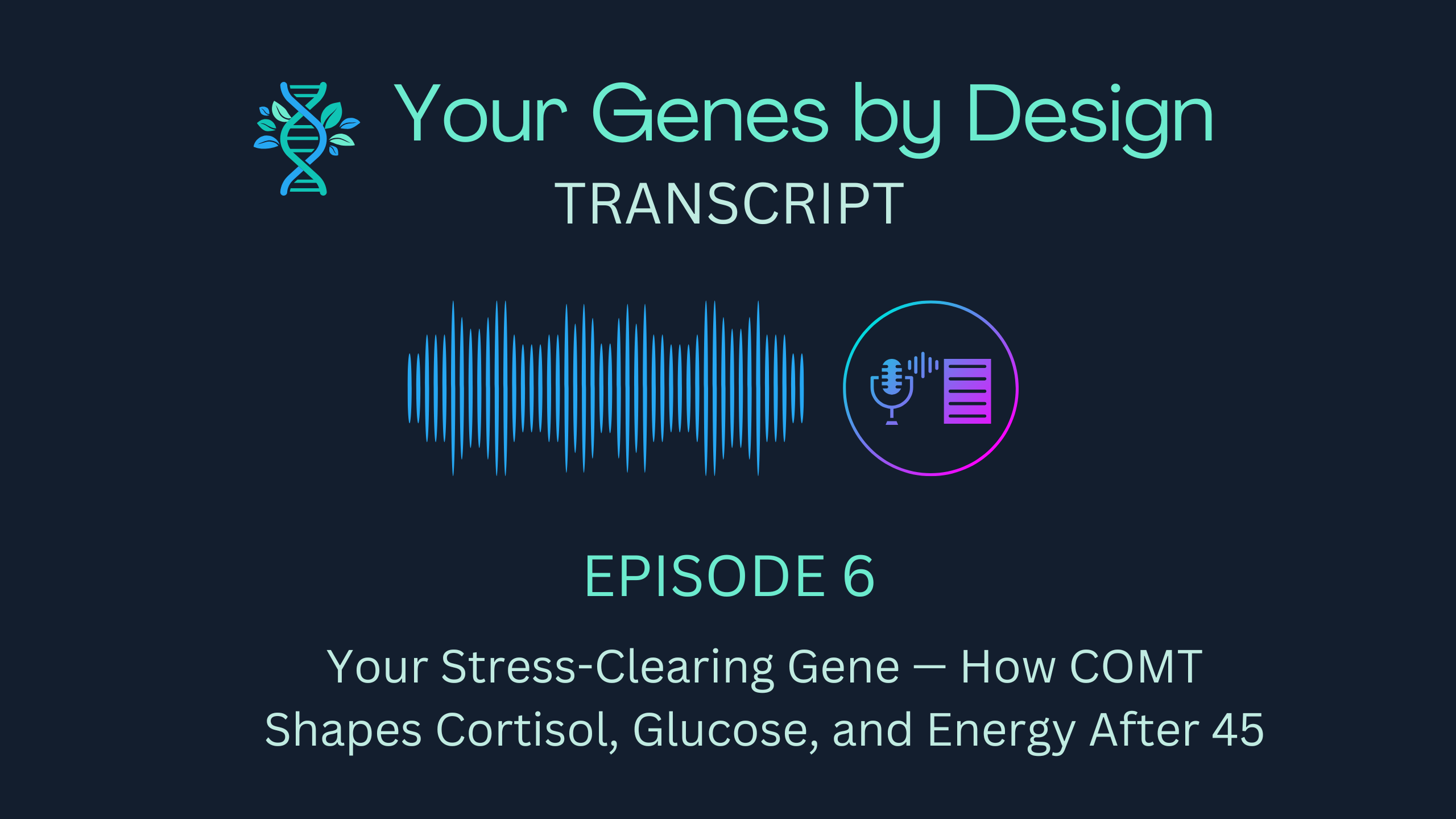
0:00 Intro Music
Your Genes by Design Podcast with Lauri Wakefield
00:31 — Welcome And Series Context
Hi, I’m Lauri. Thanks so much for joining me today. This is the sixth episode in the Glucose and Insulin by Design series. Today we’re going to look at how stress chemistry shapes blood sugar in a way that has nothing to do with what you eat — and why this becomes more noticeable after the age of 45.
And it starts with what happens inside your body the moment you feel stress. Every time your brain senses pressure, even low-grade, day-to-day stress, it signals your adrenal glands to release cortisol. Cortisol’s job is simple. It’s to free up glucose so you can think, move, and respond. In short bursts, this can be helpful, but when stress becomes your baseline, glucose can stay elevated long after the stressful moment has passed.
1:09 — Stress Chemistry Raises Glucose
And that’s where the COMT gene becomes important. COMT stands for catechol-O-methyltransferase, and its job is to clear stress chemicals like dopamine, norepinephrine, and epinephrine after your body has used them.
1:43 — Meet COMT: The Cleanup Crew
Think of COMT as a cleanup crew that restores calm after an adrenaline moment. When the system works smoothly, your stress levels go back down after the stressor has passed. But if your COMT enzyme runs more slowly because of a gene variant, those stress chemicals linger longer and can keep your cortisol and glucose levels slightly elevated even when you’re no longer under pressure. You might feel restless, crave quick carbs, or find yourself awake at three o’clock in the morning and have a hard time falling back asleep.
2:29 — Estrogen Fluctuations After 45
Let’s look at why this matters after the age of 45. Estrogen levels fluctuate after 45 because estrogen uses the same COMT pathway. Those fluctuations can change how quickly COMT works. On higher-estrogen days, that shared pathway can slow COMT down even more, especially for women with a naturally slower COMT variant. That means stress lingers longer, keeping your system in alert mode even when nothing stressful is going on. When estrogen drops, COMT can speed up, which may shift your mood, focus, and stress sensitivity in the other direction. These swings make your stress response feel less predictable. So if pressure feels heavier than it used to, or it takes longer to unwind, it’s not just midlife stress. It’s biology — your changing hormones and your COMT type working together.
3:24 — Slow vs Fast COMT Traits
So here’s the genetic layer. COMT is your main stress-processing gene. It’s responsible for clearing stress chemicals like dopamine, epinephrine, and norepinephrine, and it quietly influences glucose regulation because prolonged stress chemistry signals the liver to release more glucose. If you have a slow COMT variant, your system takes longer to clear those stress chemicals, which can keep glucose elevated longer. If your COMT variant is the faster type, you clear those chemicals more quickly, which can support resilience but sometimes leads to dips in focus or feeling mentally drained sooner. Your COMT type also influences how sensitive you are to stimulation — things like caffeine, multitasking, transitions, or even background noise. All of these shape your daily cortisol rhythm.
4:03 — Daily Signs Of Your Stress Rhythm
You may notice your COMT rhythm in small everyday moments like feeling alert at night but low on energy in the morning, craving quick-energy foods after emotional stress, struggling to wind down at bedtime, or feeling overstimulated in busy or noisy environments. Each of these is a reflection of how your nervous system processes and recovers from stress.
4:36 — Precision Strategies By COMT Type
So here’s the precision piece. Understanding your COMT variant helps you support your natural way of recovering from stress. If you have a slower COMT variant, build natural pauses into your day — a short walk, a breathing break, or a transition routine between tasks. Magnesium-rich foods like leafy greens, cacao, and seeds can also support this pathway. If you have a faster COMT variant, support dopamine steadiness with protein-rich meals and meaningful breaks that help reset focus. Structure often feels calming for fast-COMT types. If you have an intermediate COMT variant, meaning it’s neither fast nor slow, you may notice both sides — sensitivity to buildup and the ability to bounce back with consistency. Routines that anchor your day can help keep things balanced.
5:56 — Resources And Closing
Precision is about working with the way your chemistry naturally shifts from stress to recovery. Your stress-clearing gene helps explain your rhythm. It lets you know whether your body needs more transitions or more structure, more quiet focus or more intentional reset moments. And when you understand your COMT type, you can work with your design instead of fighting against it. Glucose levels become more steady, energy becomes more predictable, and daily stress becomes more manageable instead of a reaction you can’t control.
If you don’t know what gene variants you have or how you can find out, I’ll be publishing a series of three or four articles in my Your Genes by Design newsletter on Substack that helps explain all of this. I’ll link to it in the show notes.
If this episode helps you understand why stress and energy feel different after the age of 45, follow the Your Genes by Design podcast for more short, science-based insights made practical for real life. And if you found it helpful, please share it with another woman who might benefit from it.
You can also explore The Oxygen Connection, a free resource that expands on how oxygen, glucose, and your genes work together to create steady energy after 45. That’s going to wrap things up for this episode. Thanks again for joining me, and have a great day.
